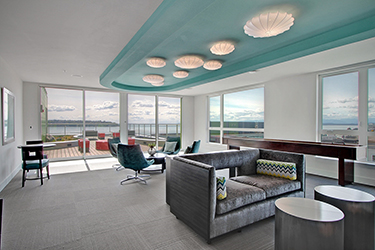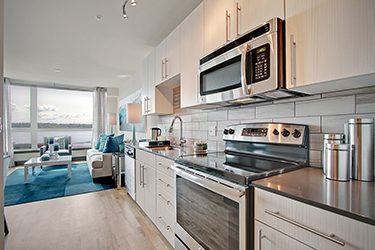|
Subscribe / Renew |
|
|
Contact Us |
|
| ► Subscribe to our Free Weekly Newsletter | |
| home | Welcome, sign in or click here to subscribe. | login |
Real Estate
| |
 |
June 26, 2014
Bachelorette flats: The new face of multifamily
Pastakia + Associates

Pastakia
|
The world has discovered Seattle.
With the spotlight on our city, newcomers are moving here now more than ever. The demand for new places to live, work, shop and play is occurring at a breakneck pace in a real estate industry that was severely impacted during the recession.
As the urban core is being redefined, the age-old concept of mixed-use that was abandoned in the 1950s is back with vigor. What’s different in this cycle is that development includes the influence of many more women, who bring a distinctive set of ideas to the table and have a marked impact on the success of the mixed-use concept.
With financial capital fueling the economic up-cycle and an unprecedented number of multifamily units in the pipeline, the flurry of activity has allowed more women to enter the construction industry with fresh insights and ideas that are influencing how buildings are designed, constructed and programmed.
Not the 1950s anymore
What typically had been a one-user experience is now much more multifaceted. Throughout my career — from architect to real estate advisor to project manager — I have worked on a variety of living environments and this technical experience combined with my understanding of how men and women use space differently allows me to bring buildings on line that allow placemaking to take the forefront in development.
With over 11,000 apartment and condominium units in the Seattle development pipeline, the successful projects are going to be the ones that take a multifaceted approach.
For instance, how does the building interact with its environment so that the residents feel part of the community? How does the building achieve the goals and objectives of its investors while also respecting the long-term housing needs and the historical heritage of its neighborhood? As design and budget decisions are made, are we considering how males and females use spaces differently?
For me — working behind the scenes and solving complex development problems while making sure that the final objective is met — a successful project is similar to raising my children to become well-adjusted adults.
More single women renters
In the 1950s, multifamily development was designed for bachelors or the “Mad Men” urban loft. Today, more and more women are choosing to live in urban centers and they have specific details that they are looking for in multifamily buildings.
Women want safety, security, warmth and comfort — all of which can drastically change how a mixed-use apartment building is designed and developed. For example, prior to the recession, the focus on finishes, indoor community spaces and secured access was more of a developer’s afterthought. Today, a successful project will focus on all of the above and pay attention to the little details that make a big difference in leasing an apartment.
Some of those details are sparkling quartz countertops, more daylight, kitchens that entertain (even in a studio apartment), cozy conversation areas in communal spaces, and a dog lounge that is safe and secure at night.
In today’s multifamily market, success is in the details.
That is where I think women in the construction industry are having the biggest success and influence: as real estate investment and project managers. Every day, I juggle a myriad of technical, logistical and design details for my clients. I am both the strategic thinker and the task manager. So, it helps that I also think like a woman when it comes to looking at site acquisition, design layout, where to invest and how to get it all done on time and on budget.
This unique gender perspective brings a new brand of thinking. Marrying economics with design and creating a true balance between the two, that’s the real challenge and the opportunity.
A few Peggy Olsons
Does Seattle have a Peggy Olson (the enterprising businesswoman of “Mad Men”) of construction management?
Yes. We are fortunate to have a few Peggy Olsons who are changing the urban form of our landscape and leading the way from the one-user, single-focus multifamily development of the 1950s to the multiuser, denser, pedestrian-oriented development of today.
Thinking back on my own career and unbeknownst to me at the time, my concepts for providing creative solutions for my clients — to maximize their returns while providing the community with a built product that creates a sense of place — are firmly based in my female sensibilities. For me this has evolved into a firm of best practices.
Over the years, both local and outside developers have contributed to our firm’s database of knowledge and given my team our own playbook of best practices. Our clients are learning that this unique skill set is highly valuable in this competitive environment.
So the next time you walk into an apartment building filled with light, see a piece of art strategically placed to give you pause for thought, or drive by a restaurant teeming with energy, you now know there is a high probability that there is a Peggy Olson working behind the scenes to pitch and mold our city into the best urban landscape for today and tomorrow.
Tejal Pastakia is a principal of Pastakia + Associates, a Seattle-based developer specializing in mixed-use, urban infill projects in the Puget Sound area.
Other Stories:
- Placemaking is at the heart of urban infill
- Big changes for the Seattle waterfront
- Demographics, jobs pump up apartment demand
- Prefab construction: Good to the urban core
- Rent hikes ripple to the suburbs
- A closer look at what’s driving the apartment boom
- We need housing -- and jobs -- near transit stations
- Affordable housing gap widens downtown
- 7 trends that will keep the good times rolling




